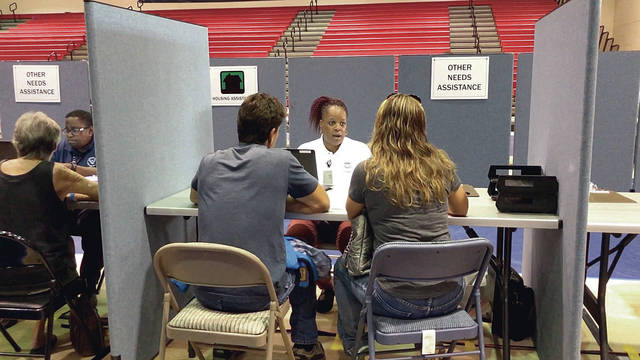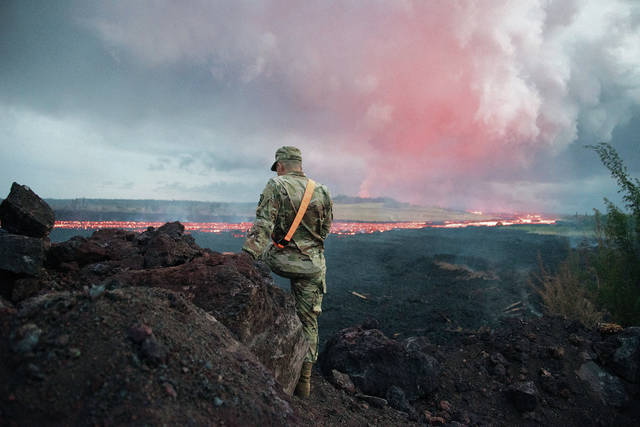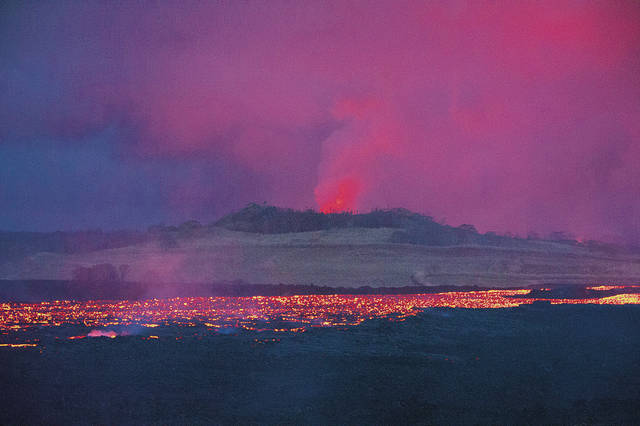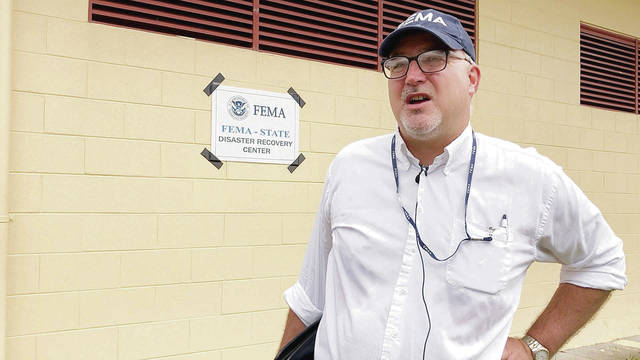Big Island disaster survivors flow into a FEMA aid center on opening day


SARAH DOMAI / SDOMAI@STARADVERTISER.COM
Puna residents who suffered damage or losses from the volcanic activity learned Friday about help available at the Federal Emergency Management Agency’s Disaster Assistance Center set up inside the Keaau High School gym.

SARAH DOMAI / SDOMAI@STARADVERTISER.COM
A lava river flowed into Kapoho Bay on Thursday.

CRAIG T. KOJIMA / CKOJIMA@STARADVERTISER.COM
A lava river flowed to Kapoho Bay on Thursday evening. The photograph was taken about 1.5 miles from the bay and 5 miles from fissure 8. The lava river was about 100 yards wide.

SARAH DOMAI / SDOMAI@STARADVERTISER.COM
“In the case of a wildfire or volcanic eruption, the disaster is still ongoing, so we kind of have to roll into the recovery phase when the response phase is still going on,” said David Mace, FEMA media relations manager.





KEAAU, Hawaii >> Randy and Kathleen Kalauli still looked a bit shellshocked when they showed up Friday morning on opening day of the Federal Emergency Management Agency’s Disaster Assistance Center set up inside the Keaau High School gym.
They lost their Vacationland home of 20 years and just about everything else they owned when lava from Kilauea Volcano swept through the coastal subdivision in late May.
“We lost everything. There’s nothing there — appliances, my tools,” said Randy Kalauli, 68, a retired asphalt construction worker.
“It’s sad. It’s horrible,” added Kathleen Kalauli, 67, who retired from her job working for an insurance company.
The couple, who have been living for almost three weeks at the American Red Cross shelter at the Pahoa Community Center and Regional Park, said they had planned to spend the rest of their days in their home. They said they would like to rebuild, even on lava if they have to, and were hoping to find some kind of assistance from government agencies that help disaster victims.
>> Illness keeps Big Isle Mayor Kim off the job — at least for a day
>> Kilauea eruption is classic example of ‘gentle’ volcano
>> Ashfall, vog lowers air quality for residents of Ocean View
>> Big Isle tourism campaign gets love in Ohio
>> Kilauea isn’t Hawaii’s only active volcano
RELATED PHOTOS AND VIDEOS
>> Live webcams from Hawaii island
>> Newly opened center is a one-stop shop for Kilauea disaster survivors on Hawaii island, June 15
>> Dramatic footage from Kilauea’s most active fissure: No. 8, June 15
>> Pahoa business owners talk about drop in business, June 14
>> Heavy vog invades Ocean View, June 14
>> USGS: Kilauea Volcano fissure 8 flow from vent to sea, June 14
>> Influx of new people at Hawaii island Red Cross shelter has brought more crime, June 13
>> Animals on Hawaii island find refuge from lava at local farm, June 13
Don't miss out on what's happening!
Stay in touch with breaking news, as it happens, conveniently in your email inbox. It's FREE!
COMPLETE KILAUEA COVERAGE
>> Star-Advertiser volcano coverage
>> Kilauea Volcano YouTube playlist
Residents who suffered damage or losses from the volcanic activity that started May 3 can register for FEMA programs and other aid at the Disaster Assistance Center, which is open daily from 8 a.m. to 8 p.m. By the end of Friday, 400 people had walked through the door, according to FEMA.
Bus service is being provided from the Red Cross shelters in Pahoa and Keaau between 7:30 a.m. and 9 p.m.
Along with FEMA officials, representatives from the Red Cross, Veteran Affairs, the U.S. Small Business Administration and state agencies that deal with social and mental health services, taxes and unemployment are there to provide information. Available aid includes grants for rental assistance and immediate losses, such as those for medication and medical expenses.
FEMA media relations manager David Mace called the newly opened center “a one-stop shop for disaster survivors.”
“FEMA’s role is to register survivors for assistance through FEMA’s individual assistance programs, but we also have a number of partners here.”
Hawaii County estimates 467 dwellings, and perhaps as many as 700, have been destroyed by lava flows.
The Kilauea eruption offers a few unique challenges for recovery response agencies, Mace said. For one thing, assessors normally visit sites to document damage and losses, but many of the Puna communities affected by the eruption are covered in lava and/or may be inaccessible. In those cases they will be relying on maps and before-and-after photos, he said.
The nature of the Puna natural disaster is another twist, according to Mace.
“The only analogy I can draw is working a wildfire. Generally, the response phase to a disaster is a short one, a day or two in the case of a hurricane or flood,” he said. “In the case of a wildfire or volcanic eruption, the disaster is still ongoing, so we kind of have to roll into the recovery phase when the response phase is still going on.”
Despite its name, the SBA also is deeply involved in helping households, said public information officer Garth MacDonald. In fact, he said, the federal agency is the biggest source of funds for individuals affected by natural disasters.
Unlike organizations that focus on immediate relief efforts, MacDonald said the SBA looks at supporting long-term recovery in “getting people back to their pre-disaster condition as soon as we can.”
Pahoa resident Jerry Julian said he is hoping to get back to farming as soon as he can. His 700 papaya trees in Kapoho were consumed by lava.
The 58-year-old Pahoa resident wasn’t sure what FEMA and other agencies could do for him, but he showed up at the Disaster Recovery Center Friday morning hoping to find a way to keep farming.
“I’m trying to plant more if I can find land,” said Julian, 58.
For a list of information on what residents should bring to the center, visit disasterassistance.gov.
Meanwhile, eruption activity in the lower East Rift Zone continued largely unchanged Friday, with lava from the dominant fissure 8 streaming into Kapoho Bay, producing a “laze” plume.
Other volcano developments
>> A 5.3-magnitude earthquake centered in the summit region of Kilauea was reported at 12:05 p.m. Friday. The Hawaiian Volcano Observatory said the shaking sent a small ash plume up to 10,000 feet into the air.
>> Residents of Kealakekua and surrounding areas can get information on vog and ash impacts and precautions at a community meeting at 5:30 p.m. Wednesday at the Konawaena Elementary School cafeteria. Representatives from the U.S. Geological Survey, state Department of Health and Hawaii County Civil Defense will be there.






